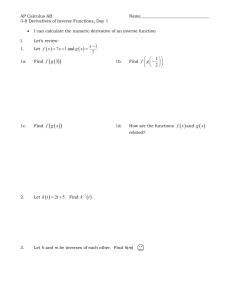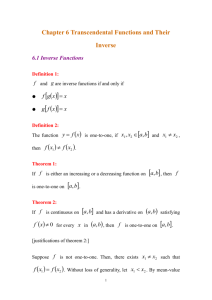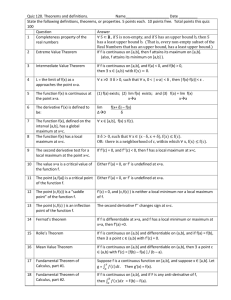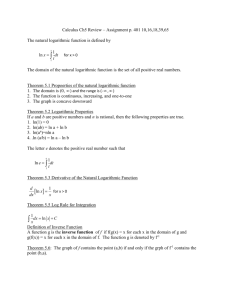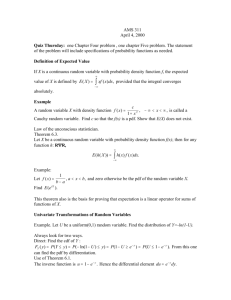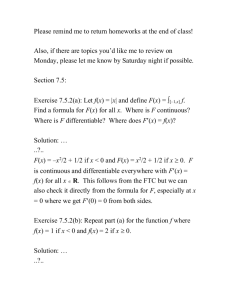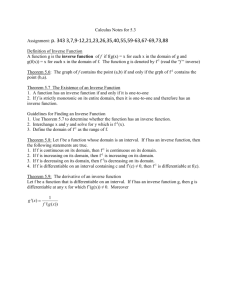Chapter 5 Theorems
advertisement
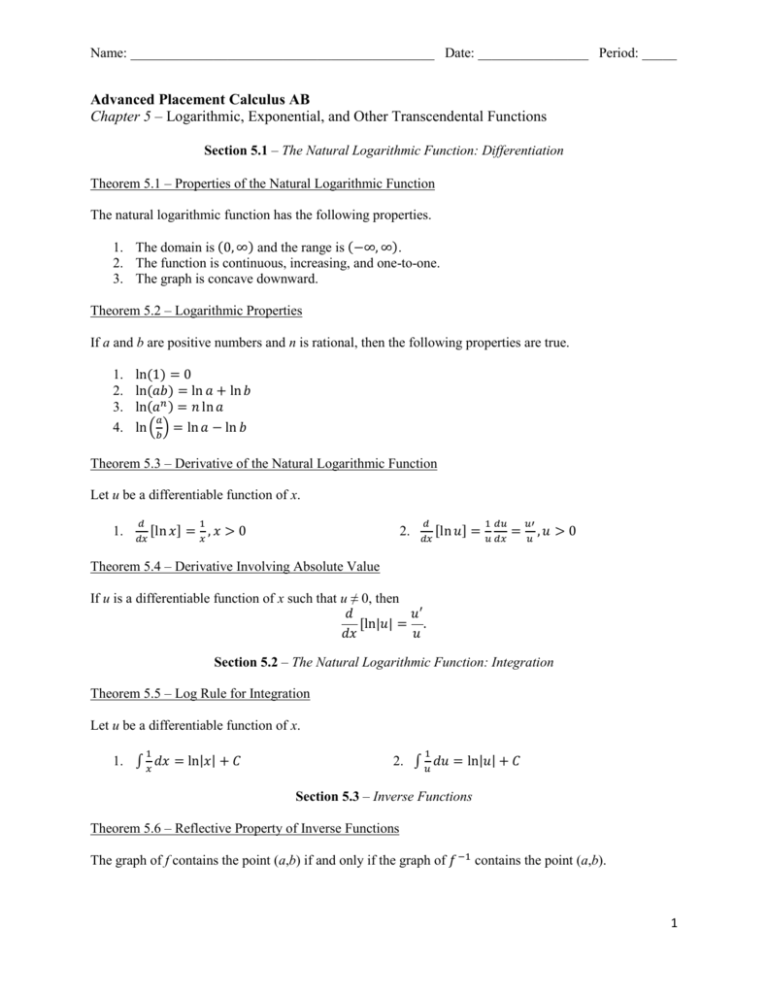
Name: ____________________________________________ Date: ________________ Period: _____ Advanced Placement Calculus AB Chapter 5 – Logarithmic, Exponential, and Other Transcendental Functions Section 5.1 – The Natural Logarithmic Function: Differentiation Theorem 5.1 – Properties of the Natural Logarithmic Function The natural logarithmic function has the following properties. 1. The domain is (0, ∞) and the range is (−∞, ∞). 2. The function is continuous, increasing, and one-to-one. 3. The graph is concave downward. Theorem 5.2 – Logarithmic Properties If a and b are positive numbers and n is rational, then the following properties are true. 1. 2. 3. 4. ln(1) = 0 ln(𝑎𝑏) = ln 𝑎 + ln 𝑏 ln(𝑎𝑛 ) = 𝑛 ln 𝑎 𝑎 ln (𝑏 ) = ln 𝑎 − ln 𝑏 Theorem 5.3 – Derivative of the Natural Logarithmic Function Let u be a differentiable function of x. 1. 𝑑 [ln 𝑥] 𝑑𝑥 1 = 𝑥,𝑥 > 0 2. 𝑑 [ln 𝑢] 𝑑𝑥 1 𝑑𝑢 = 𝑢 𝑑𝑥 = 𝑢′ ,𝑢 𝑢 >0 Theorem 5.4 – Derivative Involving Absolute Value If u is a differentiable function of x such that u ≠ 0, then 𝑑 𝑢′ [ln|𝑢| = . 𝑑𝑥 𝑢 Section 5.2 – The Natural Logarithmic Function: Integration Theorem 5.5 – Log Rule for Integration Let u be a differentiable function of x. 1 1. ∫ 𝑥 𝑑𝑥 = ln|𝑥| + 𝐶 1 2. ∫ 𝑢 𝑑𝑢 = ln|𝑢| + 𝐶 Section 5.3 – Inverse Functions Theorem 5.6 – Reflective Property of Inverse Functions The graph of f contains the point (a,b) if and only if the graph of 𝑓 −1 contains the point (a,b). 1 Theorem 5.7 – The Existence of an Inverse Function 1. A function has an inverse function if and only if it is one-to-one. 2. If f is strictly monotonic on its entire domain, then it is one-to-one and therefore has an inverse function. Theorem 5.8 – Continuity and Differentiability of Inverse Functions Let f be a function whose domain is an interval I. If f has an inverse function, then the following statements are true. 1. 2. 3. 4. If f is continuous on its domain, then 𝑓 −1 is continuous on its domain. If f is increasing on its domain, then 𝑓 −1 is increasing on its domain. If f is decreasing on its domain, then 𝑓 −1 is decreasing on its domain. If f is differentiable on an interval containing c and 𝑓 ′ (𝑐) ≠ 0, then 𝑓 −1 is differentiable at f(c). Theorem 5.9 – The Derivative of an Inverse Function Let f be a function that is differentiable on an interval I. If f has an inverse function g, then g is differentiable at any x for which 𝑓 ′ (𝑔(𝑥)) ≠ 0. Moreover, 1 𝑔′ (𝑥) = ′ , 𝑓 ′ (𝑔(𝑥)) ≠ 0. 𝑓 (𝑔(𝑥)) Section 5.4 – Exponential Functions: Differentiation and Integration Theorem 5.10 – Operations with Exponential Functions Let a and b be any real numbers. 1. 𝑒 𝑎 𝑒 𝑏 = 𝑒 𝑎+𝑏 2. 𝑒𝑎 𝑒𝑏 = 𝑒 𝑎−𝑏 Theorem 5.11 – Derivatives of the Natural Exponential Function Let u be a differentiable function of x. 1. 𝑑 [𝑒 𝑥 ] 𝑑𝑥 = 𝑒𝑥 2. 𝑑 [𝑒 𝑢 ] 𝑑𝑥 𝑑𝑢 = 𝑒 𝑢 𝑑𝑥 Theorem 5.12 – Integration Rules for Exponential Functions Let u be a differentiable function of x. 1. ∫ 𝑒 𝑥 𝑑𝑥 = 𝑒 𝑥 + 𝐶 2. ∫ 𝑒 𝑢 𝑑𝑢 = 𝑒 𝑢 + 𝐶 2 Section 5.5 – Bases Other than e and Applications Theorem 5.13 – Derivatives for Bases Other than e Let a be a positive real number (a ≠ 1) and let u be a differentiable function of x. 1. 3. 𝑑 [𝑎 𝑥 ] 𝑑𝑥 = (ln 𝑎)𝑎 𝑥 𝑑 [log 𝑎 𝑥] 𝑑𝑥 1 = (ln 𝑎)𝑥 2. 𝑑 [𝑎𝑢 ] 𝑑𝑥 𝑑𝑢 4. 𝑑 [log 𝑎 𝑢] 𝑑𝑥 = (ln 𝑎)𝑎𝑢 𝑑𝑥 1 𝑑𝑢 = (ln 𝑎)𝑢 𝑑𝑥 Theorem 5.14 – The Power Rule for Real Numbers Let n be any real number and let u be a differentiable function of x. 1. 𝑑 [𝑥 𝑛 ] 𝑑𝑥 = 𝑛𝑥 𝑛−1 2. 𝑑 [𝑢𝑛 ] 𝑑𝑥 = 𝑛𝑢𝑛−1 𝑑𝑢 𝑑𝑥 Theorem 5.15 - A Limit Involving e 1 𝑥 𝑥+1 𝑥 lim (1 + ) = lim ( ) =𝑒 𝑥→∞ 𝑥→∞ 𝑥 𝑥 Section 5.6 – Inverse Trigonometric Functions: Differentiation Theorem 5.16 – Derivatives of Inverse Trigonometric Functions Let u be a differentiable function of x. 1. 𝑑 [arcsin 𝑢] 𝑑𝑥 = 𝑢′ 3. 𝑑 [arctan 𝑢] 𝑑𝑥 = 1+𝑢2 1. 𝑑 [arcsec 𝑢] 𝑑𝑥 = √1−𝑢2 𝑢′ 𝑢′ |𝑢|√𝑢2 −1 2. 𝑑 [arccos 𝑢] 𝑑𝑥 = −𝑢′ 4. 𝑑 [arccot 𝑢] 𝑑𝑥 = 1+𝑢2 6. 𝑑 [arccsc 𝑢] 𝑑𝑥 = √1−𝑢2 −𝑢′ −𝑢′ |𝑢|√𝑢2 −1 Section 5.7 – Inverse Trigonometric Functions: Integration Theorem 5.17 – Integrals Involving Inverse Trigonometric Functions Let u be a differentiable function of x, and let a > 0. 𝑑𝑢 𝑢 1. ∫ 2 2 = arcsin + 𝐶 𝑎 √𝑎 −𝑢 𝑑𝑢 1 𝑢 2. ∫ 2 2 = arctan + 𝐶 𝑎 +𝑢 𝑎 𝑎 𝑑𝑢 1 3. ∫ = arcsec 𝑎 𝑢√𝑢2 −𝑎2 |𝑢| 𝑎 +𝐶 3
